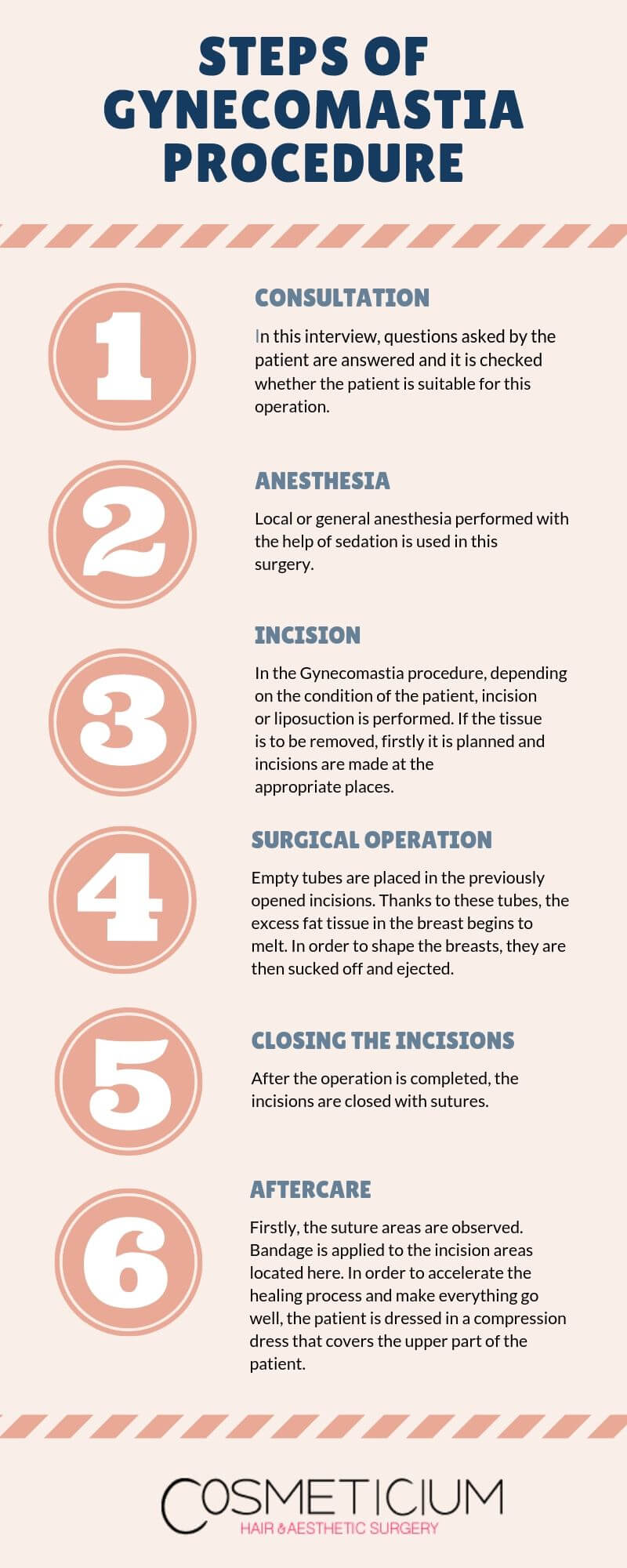Gynecomastia is a condition where men’s breasts are larger and saggy than normal. This common condition usually does not pose any health risk, but in some cases may be a symptom of a different disease. The underlying cause of this problem is the imbalance in the levels of oestrogen and testosterone hormones. One or both breasts may be affected at the same time. What causes gynecomastia? How are diagnosis and treatment performed? What do you need to know before gynecomastia surgery?
Table of Contents
Factors Causing Gynecomastia
There are some factors that affect the risk of gynecomastia. Some of these factors include:
- Abnormal changes in testosterone levels in adolescence and post-puberty
- Oestrogen transmission from mother to baby during pregnancy
- Diseases such as kidney, liver, diabetes and obesity
- Use of addictive and harmful substances such as alcohol, cannabis and heroin
- The presence of this condition in other members of the family
- External oestrogen exposure
The above conditions do not necessarily cause gynecomastia but increase the risk factor. Therefore, people with these conditions need to be more careful and have themselves checked frequently than others. When gynecomastia begins to develop, pain and tenderness will usually occur in the breasts. Other than that, the areola will be a little bigger and the liquid will come out of the nipple. However, it should not be forgotten that it may still develop without these conditions.
You May Also Like: What Are the Main Causes of Gynecomastia?
How is Gynecomastia Diagnosed?
For the diagnosis of gynecomastia, breast examination is usually sufficient. In some cases, however, the examination is more extensive. Apart from the breasts, the penis and testes may also need to be examined. Depending on the data obtained, different tests may be required. Some of the tests used to diagnose gynecomastia include below.
Different imaging tests may be used to determine the exact cause of gynecomastia and also to see if there is a risk for a different disease.
- Testes, pituitary and liver are examined for the presence of a mass using imaging tests such as MRI, ultrasound and CT scan.
- A blood test is performed to determine your hormone levels.
- If any mass is detected, a biopsy is performed to examine it.
You May Also Like: Steps of Gynecomastia Procedure and FAQ
How is Gynecomastia Surgery Performed?
Different methods can be used to treat gynecomastia. In order to use these treatment methods, firstly the general condition of the disease is examined. First of all, hormone treatment is applied to eliminate the difference in hormone levels. If this treatment is not successful, surgical intervention is performed. In this procedure, in general, excess breast tissue is removed and the position of the breast is moved up slightly. Thus, the problem is solved smoothly.
Depending on the condition of the breast, different surgical procedures may be performed. It can be said that liposuction is a good choice if there is excessive fat in the breast tissue. However, if the removal of fat tissue is not enough, it can also be removed from other tissues in the breast and the areola is moved up a bit. It’s important that the resulting image is symmetrical.
If only liposuction is performed, the recovery period of the patients is around one week. However, it should be known that the recovery time will be a little longer if different tissues are removed apart from liposuction.

Things to Know Before Gynecomastia Surgery
There are a number of different things you should know before gynecomastia surgery. Details of these issues are given below.
Recovery Time
This procedure is ultimately a surgical operation and has its own risks. These risks should be known, and the surgery should be decided afterwards. In addition, the recovery period can be up to 4 weeks. If you have a heavy-duty at work, it is not appropriate to return to work so soon. Therefore, it is very useful to get permission from your company before the procedure.
You will have pain in the process after the procedure. To get through this period comfortably, you should use the painkillers prescribed by your doctor with no exception.
You May Also Like: Which Questions Should I Ask My Doctor About Gynecomastia Surgery?
Surgery Scar
Incisions are made by your doctor for gynecomastia surgery. Depending on the procedure performed, it can be said that their sizes will vary. However, it is not easy to hide these incisions in men and there may be some scars after surgery.
If your preferred doctor is an expert in this field, there won’t be any scars after the procedure. Experienced physicians make much smaller incisions and make these on concealable areas in the areola region. Even if there are scars left here, they disappear after a while and they are never permanent. However, if a wrong physician is preferred, it is almost inevitable to experience permanent scars.
Cost
Gynecomastia surgery is usually not covered by insurance companies. Especially when there is no direct or indirect effect on health, this surgery is considered aesthetic and insurance companies do not pay for it. In this context, the cost of the surgery in question should be learned.
The cost of gynecomastia surgery varies according to the preferred clinic and the specialist physician who will perform the procedure. In addition, the way the procedure is performed as well as the general condition of the patient also affects the cost.
You Can Check Out This Page to Get More Information About Gynecomastia Surgery in Turkey

